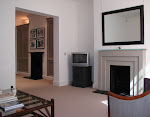 If traditional sash windows are the only barrier between us and London traffic we might be able to tackle the problem simply by improving or installing draught seals. As well as draughts, these seals also reduce airborne noises which find their way through the smallest and least noticeable gap.
If traditional sash windows are the only barrier between us and London traffic we might be able to tackle the problem simply by improving or installing draught seals. As well as draughts, these seals also reduce airborne noises which find their way through the smallest and least noticeable gap.If the problem persists one might be tempted to consider secondary glazing. Effective as this solution may be, the “aesthetic” compromises it implies often mean it is not a viable solution. If secondary glazing is not an option the sash window glazing needs to be addressed. This will need to be upgraded to a “sealed unit”, i.e. two sheets of glass sealed on all fours sides and installed, in the case of sash windows, within the sash bars. One of the sheets of glass used is often an acoustic glass. There are many types of acoustic glass, available in various thicknesses (4.4mm to 12.8mm in terms of window glazing) and designed to control various levels and types of noise. Developed and tested by the larger glass manufacturers (e.g. Pilkington Glass) the results are often not as impressive in real life situations as they may be on paper. Noise travels in waves on varying frequencies. Sound insulating materials attempt to control noise by disrupting the flow of these waves. Every time the wave passes through a barrier it is diminished and the shape of the wave is altered. Acoustic (laminated) glass is comprised of 2 or more layers, laminated together with a special film separating the layers. As the sound wave passes through each layer it is diminished: the thicker the sheet the more effective in breaking down the sound.
Here comes the inevitable compromise: as the glass gets thicker it also becomes heavier and so the weights used to raise the traditional box sash window will have to be increased accordingly. More weights will result in less room to move within the box itself and the window will therefore become less functional: the weights will have nowhere to slide and one of the sashes will effectively become fixed.
The “art” of compromise is therefore based on understanding. Sound insulation is probably best achieved via well fitted windows with good draught strips, laminated safety glass 4.4mm or 6.4 mm thick may not be quite as acoustically efficient as the best specialist glass but, at a fraction of the price, it will dramatically assist in an overall noise reduction plan.

No comments:
Post a Comment